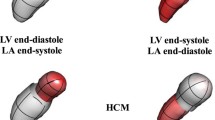Abstract
Coronary artery disease producing ischemic cardiomyopathy is the most frequent cause of left ventricular systolic dysfunction. Non-ischemic cardiomyopathies can also produce systolic dysfunction; they may be inherited as genetic disorders or occur sporadically. These coronary injuries have repercussions on the left ventricle producing changes on wall contractility, the shape of the cavity and also changes on ventricular function. This study is focused on the 2D echocardiograms of the left ventricle. Apical two chamber and four chamber view recordings were performed on normal and systolic dysfunction subjects. Individual frames were extracted for at least five cardiac cycles. After preprocessing these images, segmentation of the left ventricle was performed by Fuzzy systems. Then the volumes were measured by single and biplane methods along with the perimeter, short axis length and long axis length in each frame, from which the two indices Sphericity Index (SI) and Normalized Eccentricity Index (NEI) was determined. It was found that the diastolic phase is short in the case of systolic dysfunction, and its volume variation is not uniform as in the normal case. Also, in the case of systolic dysfunction, the span of either the long or short axis length variation is less than 0.5 cm. This depicts that akinesis is in the corresponding direction; the value of SI is less than 2 for systolic dysfunction. A sharp peak is seen at each systole point in the NEI plot and also its variation is smooth in subjects having LVEF > 45%, which is not the case for dysfunction.
Similar content being viewed by others
References
Chavey, W. E., Blaum, C. S., Bleske, B. E., Van Harrison, R., Kesterson, S. and Nicklas, J. M.,Guideline for the Management of Heart Failure Caused by Systolic Dysfunction: Part I. Guideline Development, Etiology and Diagnosis, American Family Physician, Vol.64, No.5, pp.769–774, 2001.
Nagy, L. and Nagy, E.,Detection of ischemic cardiopathy analyzing 2D-echograms, Proceedings of 22nd Annual EMBS International Conference, Chicago, USA, 23–28 July, pp.545–547, 2000.
Giardano, A., Cornazzi, F. and Giannuzzi, P.,Automatic detection and quantification of regional wall motion, LV Function and remodeling using 2D Echocardiographic Imaging, Computers in Cardiology 1992 Proceedings, Durham, USA, 11–14 October, pp.523–526, 1992.
Van Eyll, C., Rousseau, M. F., Charlier, A. A., Van Mechelen, H., Bouvy, T., Stoleru, L., Pouleur. H.,Regional wall motion analysis in patients with idiopathic dilated cardiomyopathy, Computers in Cardiology 1991 Proceedings, Venice, Italy, 23–26 September, pp.41–44, 1991.
Manivannan, J., Ramasubba, R. M., Thanikachalam, S., Rajiv, V.,Endocardial edge detection by fuzzy inference system, TENCON 2003. Conference on Convergent Technologies for Asia-Pacific Region Proceedings, Bangalore, India, 15–17 October, Vol.1, pp.3–5, 2003.
Author information
Authors and Affiliations
Corresponding author
Rights and permissions
About this article
Cite this article
Manivannan, J., Reddy, M.R., Thanikachalam, S. et al. Detection of left ventricle systolic dysfunction from shape deformity. Australas. Phys. Eng. Sci. Med. 28, 51 (2005). https://doi.org/10.1007/BF03178864
Received:
Accepted:
DOI: https://doi.org/10.1007/BF03178864




